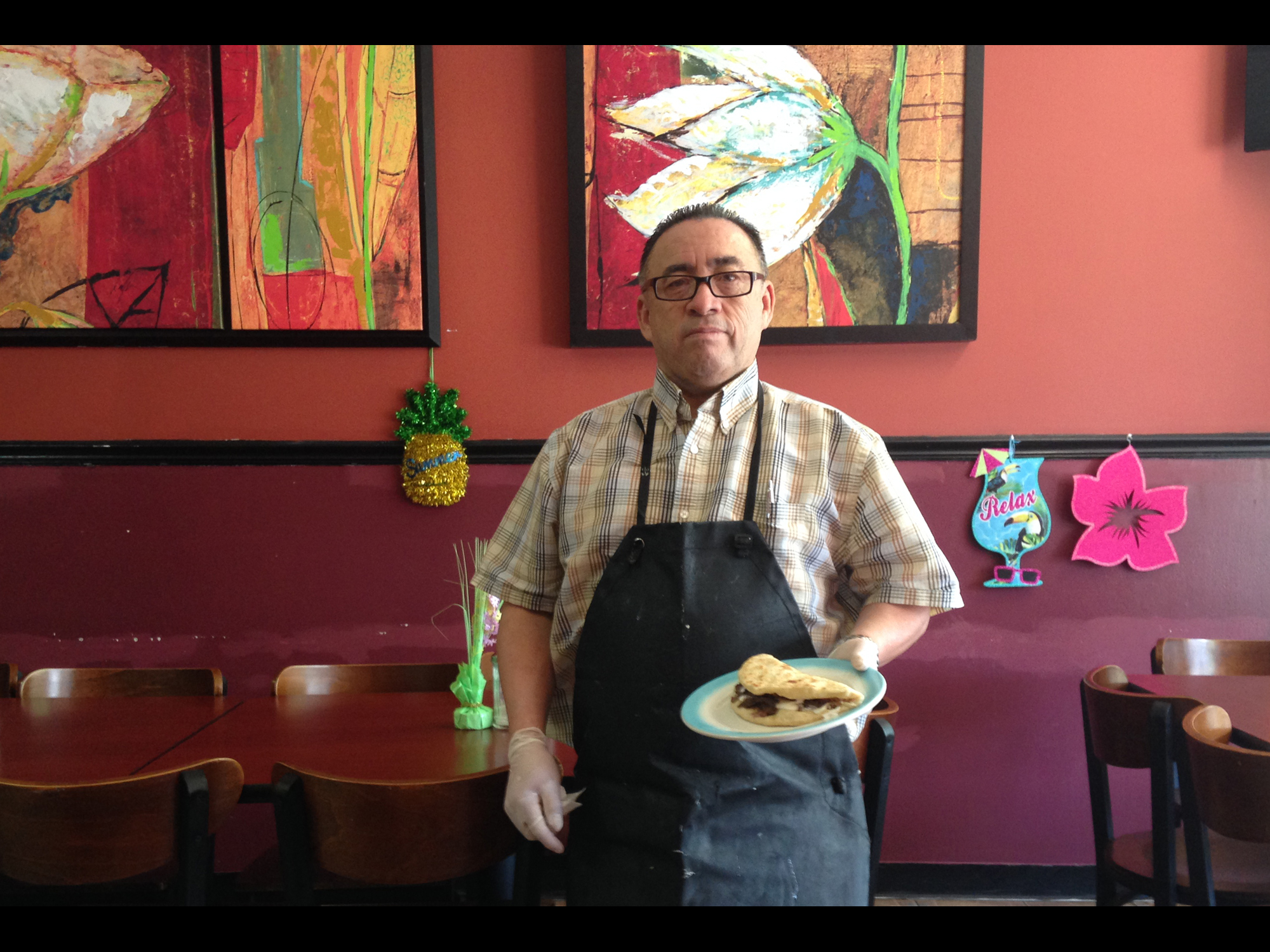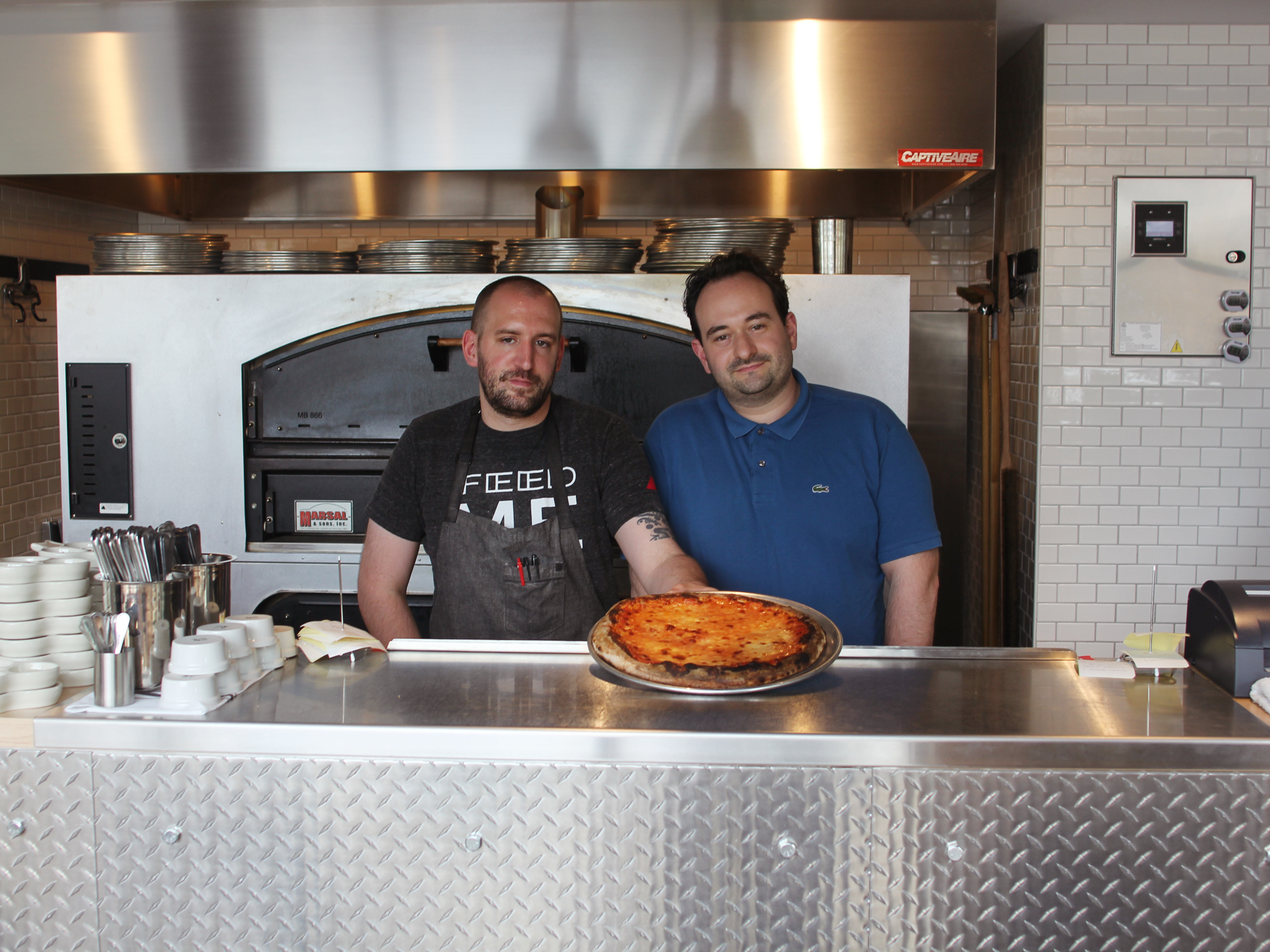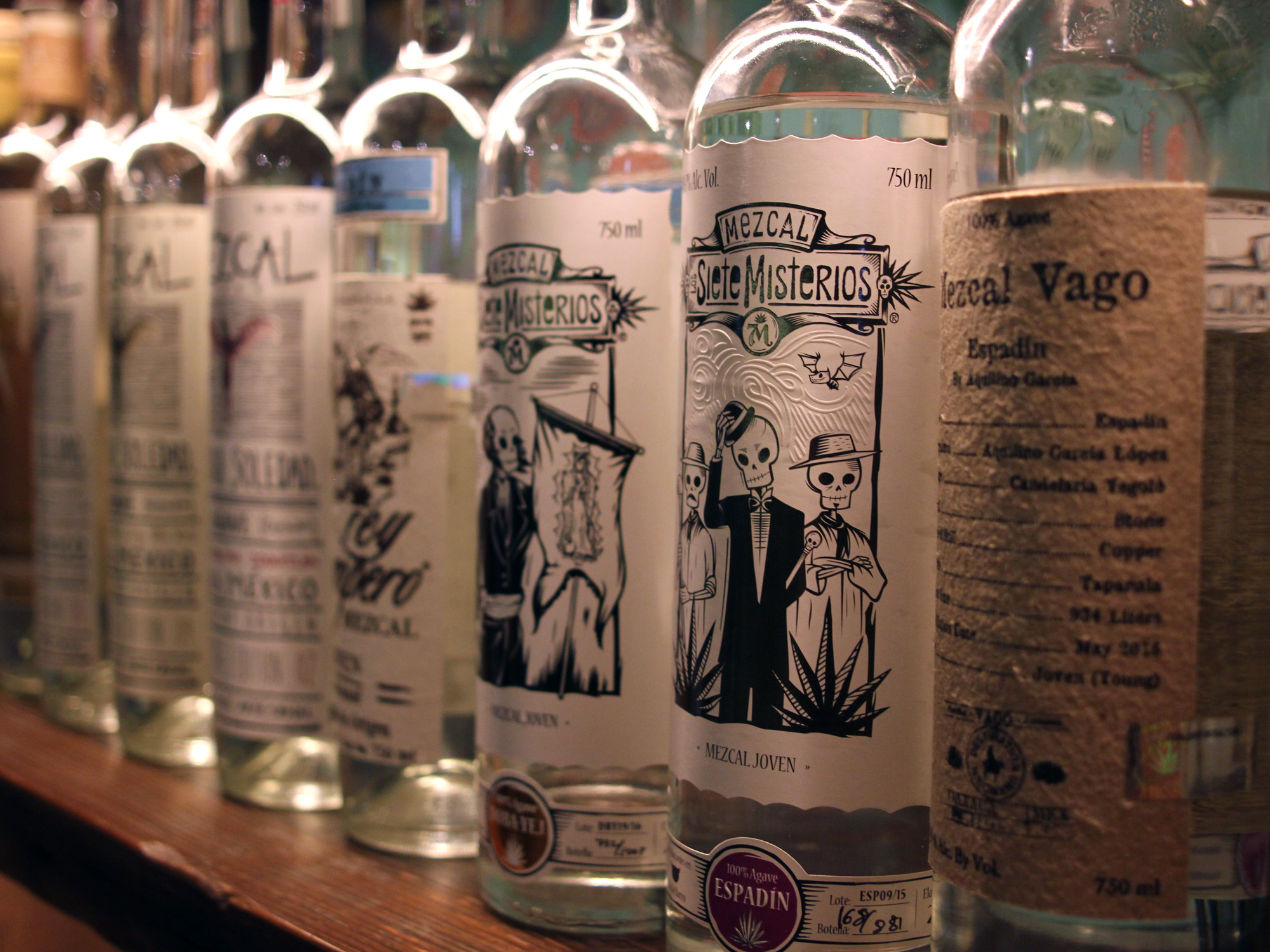LATE ON A WEEKDAY AFTERNOON, I’M sitting in Kie-Gol-Lanee, chatting with co-owners Maria “Chayo” Mendoza, Reynel Mendoza and Leonard “Leo” Ramos. Chayo usually works the front of the house at this uptown Oaxacan restaurant, though she has long experience in the kitchen; Reynel and Leo prepare most of the food. Also working in the kitchen are other co-owners: Domingo, Leo’s brother, as well as Sandra Sotz, who came to the U.S., like Chayo, as a single woman. Now, she’s married to Reynel. Kie-Gol-Lanee is definitely a family place.
Though Zapoteco is their mother tongue, Chayo, Reynel and Leo all speak Spanish and some English, and I speak only some Spanish, so I had Juan Meza sit in as translator. Bilingual Juan works at Mi Tocaya Antojeria under chef Diane Davila Boldin. Chicago restaurants are a Mexican family place, too.
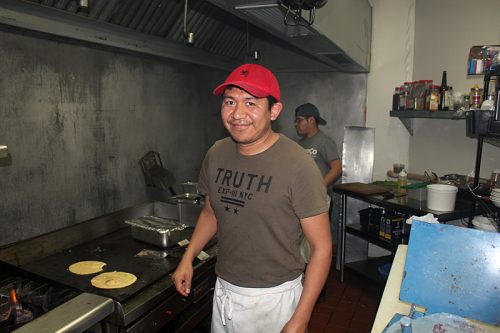
Reynel Mendoza
When Cultures Collide
THE NAME OF THE RESTAURANT, Kie-Gol-Lanee, is a phonetic version of the name of the Oaxacan village where Chayo, Reynel and Leo were born: Santa Maria Quiegolani. Quiegolani is a word in Zapoteco, and Santa Maria reflects the religious preferences of the invading Spanish. An image of the Virgin of Guadalupe is over the inside door, and at hostess station is an ofrenda, a table of offerings to Mary.
Quiegolani is translated from Zapoteco as “old stones” or “place by the river.” There are, indeed, very large stones near the present day village, which I was told are relics of indigenous people from times long past, though they do not bear inscriptions (glyphs—and perhaps even images—may have been worn off by ages and rains). Quiegolani is still by a river. The ambiguity of the name is perhaps also due to time: though Zapoteco is still spoken, it has, like all languages, evolved and perhaps been diluted by mixing with Spanish. The exact origins of the name, like the old stones, remain an ancient mystery.
Leo told us he learned to cook in Quiegolani Santa Maria, not in restaurants but in his family’s home, where he prepared platillos (small plates) of mole, which he listed as “negro, rojo, amarillo.” I asked if he made the famous Seven Moles of Oaxaca (those three as well as manchamantel, verde, chichilo, and colorodito). He assured us there were many more moles than just seven, and he’s right. On a recent trip to Oaxaca, we had mole over rice and beans every day, and the sauce on those carbs did not fall neatly into any of the standard mole categories. They were not even exactly alike, one to the other.
Essentially, mole is a sauce, and although the origin of this dish is variously claimed by Oaxaca, Puebla and Tlaxcala, it’s not unreasonable to assume that, at one time or another, the idea for sauce sprouted spontaneously in the minds of people all over Mexico and the world. Even the word “mole” is of uncertain origin: it could be derived from “moler,” the Spanish verb for “to grind,” or it could come from the Náhuatl word for “sauce.” Again, origins mysterious.
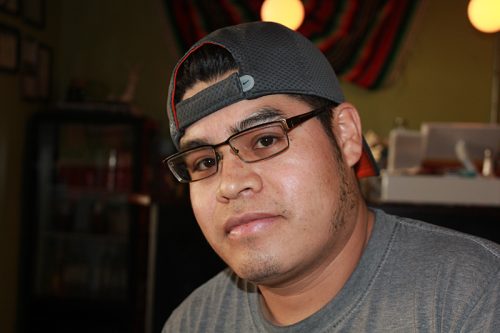
Leo Ramos
Mezcal. It’s What’s for Breakfast.
CHAYO SAID ONE THING SHE LEARNED FROM her mother was how to make rabbit in red mole. The first time I visited Kie-Gol-Lanee, I had that dish, along with a basket of housemade tortillas to lap up the remaining sauce.
My server that evening turned out to be Natalie Zarzour, formerly of the eponymous Pasticceria Natalina, a legendary Sicilian bakery in Andersonville. I reminded Natalie that the last time we saw each other, we were at an out-of-control party and she blew a big cloud of intoxicating smoke in my face. She laughed at the memory as she poured me some mezcal from her secret stash.
Given the current mezcal-mania, I asked the native Oaxacans at the table if they ever drank mezcal with dinner, as a paired beverage. No, not really was the general consensus. One might have mezcal before dinner, but not with dinner. “Mezcal is not very good with food,” Leo said. “Usually, in Oaxaca, it’s best to have mezcal in the morning. We used to have a little mezcal in our coffee, right before breakfast, no cream, no sugar, just coffee and mezcal.”
Chayo, whose uncle makes mezcal for his village back on Oaxaca, confirmed that her mother also used to follow this Oaxacan morning tradition. Every day.
“We say in Mexico,” Juan said, “that mezcal wakes up the soul.”
“Mezcal makes you hungry for breakfast,” added Leo, “and it makes you feel good the whole day.”
Now, having a blast of booze just moments after rising from bed may sound strange, but from multiple sources I’ve heard it independently confirmed that mezcal seems to have a fast onset, energizing effect. Of course, you can overdo it, but many have told me, separately and unguided, that mezcal in moderation gives one a momentary bump in “energy” (you might call it a buzz) without a corresponding drop. Mystery.
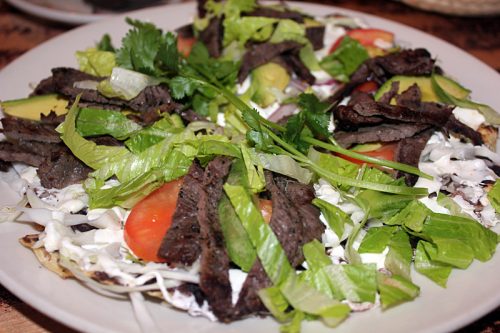
Tlayuda de cesina
Anteprima, Proving Ground for Oaxacan Chefs
LEO CAME TO CHICAGO ABOUT NINE years ago. In his first year here, he started working at Anteprima, the Andersonville Italian restaurant where Reynel also worked. Leo started prepping and doing the salads there, gaining experience with every shift.
“The things I learned at Anteprima,” he told us, “I’ve incorporated into what we serve here.” The pasta on some dishes at Kie-Gol-Lanee is the clearest reflection of his time at Anteprima.
Reynel told us that like Leo, he learned to cook at home, watching his mother and others. In traditional cultures, it’s the womenfolk who take care of cooking; in restaurant kitchens in the U.S., however, men are usually in charge. Maybe mysterious, but also entirely predictable.
If Kie-Gol-Lanee ever puts iguana in mole on the menu, I will rush to try it. Perhaps I just got a bad lizard in Tehuantepec.
At Anteprima, Reynel and the others also learned about… plating. Eating at Kie-Gol-Lanee, you’ll find many herbal garnishes that are perhaps more typical in modern Italian or American cuisines than in traditional Oaxaca cuisine. This does not make the dishes less “authentic”; they are simply reflecting how the traditional food of Mexico inevitably evolves in the U.S., as local tastes and ingredients come into play and restaurants modify their approach to suit their diners.
At Anteprima, Reynel told us, he learned “how to lose fear,” to try cooking a cuisine not his own. After that,” he said, “I was able to cook my own food and be comfortable with it. You learn other cultures and foods from all over the world, and you analyze and compare them with your hometown food, and you put the two things together.” Cuisines collide, fuse, and evolve.
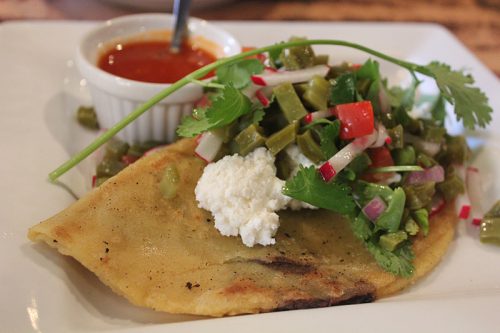
Tyacoyos de frijoles
Must-Try Dishes at Kie-Gol-Lanee
SOME THINGS YOU SHOULD EAT:
Tlacoyos de frijoles. One dish we particularly enjoyed was a starter, tlacoyos de frijoles, which beautifully embodies so much of what we admire about the food of Oaxaca: a blend of sturdy simplicity and subtle sophistication. Somewhat similar to a huarache, the tlacoyo is made of masa, ovoid or slipper-shaped, folded and stuffed with a black bean puree. The tenderness of the masa is most amazing, so delicate, topped with a salad of nopales and cheese, the diced cactus paddle dressed with a vinegar that plays against the richness of the bean and cheese and the naturally mucilaginous nopales.
Tlayuda. At Kie-Gol-Lanee, you’ll also want to order the tlayuda, which is a large, crispy crunchy tortilla, topped with salsa, fresh and fluffy cheese and some animal protein, such as pork or beef. Like pizza, the tlayuda is a flexible platform upon which you can put pretty much whatever you please. As Reynel pointed out, “You should eat tlayuda like a pizza. We see people coming in here” (by “people,” I strongly suspect Reynel meant gringos), “and they eat their tlayuda with a knife and fork, but you should eat it with your hands, just like pizza.” On our tlayuda, we had cecina (dried and rehydrated beef, which Chayo told us was typical in Oaxaca), and we enjoyed the taste very much. Still, got to say, gringo-to-gringo, I’d recommend using a knife and fork to cut through the long strands of chewy, though quite delicious, meat.
“My mother sends us the tortillas for the tlayudas,” Chayo offered, and this I found amazing, asking “You mean she sends the whole tortillas in big boxes, already cooked?” Chayo confirmed that, in fact, her mother does send the large, crisp disks of cooked masa that form the basis of the tlayuda. Although it’s prepared in her restaurant in Chicago, the tlayuda is, in a very real sense, hecho en Mexico. In these Care packages from home, which come every two-to-three weeks, Chayo’s mother also packs leaves of hoja santa and avocado, which are, Chayo says, different in Mexico and hard to acquire in Chicago.
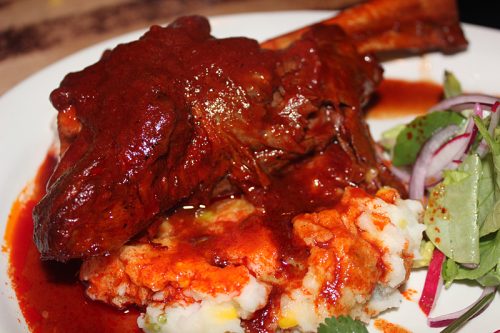
Barbacoa de borrego
Lamb barbacoa. You also want to eat the barbacoa of lamb. “In Mexico, we make barbacoa in the ground,” said Reynel, referring to the traditional in-earth ovens used to slow cook meat. In Chicago, of course, such techniques would get more than a little push-back from the Department of Health. At Kie-Gol-Lanee they use an oven, and the results are wonderful. Served with ambigu, or Oaxacan mashed potatoes, the slow-cooked lamb shank, glazed in a kind of tomato-based BBQ sauce, was fork-tender and delicious. In Oaxaca, they would have cooked the whole lamb or goat; in Chicago, they prepare only the lamb shank, explains Reynel, “because it’s easier to plate and serve.” Lessons from Anteprima, learned.
Chilacayote. For dessert, we had a few slices of chilacayote, a squash cooked in water containing piloncillo (unrefined Mexican sugar made by evaporating pure cane juice) and seasoned with cinnamon until the whole thing gets heavy and sweet, with slightly vegetable notes. Having squash for dessert may seem strange, but remember that one of our country’s signature holidays ends with a pie of pumpkin, one of the most abhorrent desserts imaginable. This candied chilacayote was immeasurably better than such Thanksgiving grotesquerie.
No, You’re the Bizarre One
DESIGNATING SOMETHING AS, SAY, “bizarre food” seems terribly ethnocentric. People, especially when hungry and lacking options, will eat anything. And even when there are options, people may choose to eat things that we don’t, which doesn’t make them bizarre and us normal. You think you eat normal food? Next time you have a Japanese or African guest at your house, serve grilled cheese sandwiches. See how that goes down.
Oaxaca is one of the most biodiverse regions of the world. There’s a lot of stuff living there. And the people of Oaxaca eat a lot of stuff we don’t – not always because they have to but because they want to.
Iguana. Perhaps the only food I’ve had in Oaxaca that I didn’t like was an iguana tamale we bought at a traditionally LGBTQ-friendly street market in Tehuantepec, where it’s said every family with a gay son feels blessed to have someone who can help tend their market stand. All cool, but man that limp, slightly fishy reptile meat in our tamale is not something I need ever try again. However, when I asked Chayo about one dish she’d loved in Oaxaca and would like to prepare at Kie-Gol-Lanee, she said without hesitation, “Iguana in mole, but I have not found where I can get iguana here.”

Dulce de chilacayote
How does one prepare iguana? “You just skin it, take all the intestines and stuff out, salt and season it, and throw it on the grill. Then you incorporate pieces of iguana into the mole.” Suffice it to say that if Kie-Gol-Lanee ever gets to put his iguana in mole on the menu, I will rush to try it. Perhaps I just got a bad lizard in Tehuantepec.
Armadillo. Another traditional, typical food of Oaxaca that Reynel would like to serve at Kie-Gol-Lanee is armadillo, which I honestly was not even sure could be eaten. Reynel really likes it, though apparently it’s hard to prepare: “You have to rip off the shell before you can skin it,” quickly adding that armadillo is “muy rico” in mole rojo, among many other preparations. “There are,” he said, “maybe one hundred recipes for armadillo,” and the preparation is usually much the same as for iguana, with some added mint and oregano. Turns out, armadillo meat, though pricey, can be acquired online. So perhaps putting armadillo on the menu at Kie-Gol-Lanee is not such an impossible dream.
Chapulines. Another Oaxacan specialty, chapulines (grasshoppers) are on the menu and are also regularly sent from Oaxaca to Kie-Gol-Lanee. Like the tortillas for tlayudas, chapulines arrive in the U.S. cooked. Reynel didn’t have any grasshoppers to serve to us that afternoon, explaining “They sell out super-fast. People come here to experiment, to try new things; they try the chapulines and they like them.” So perhaps there’s hope of seeing iguana and armadillo on the menu as well.
Mezcal Cocktails. Don’t Judge.
AFTER DINNER, NATALIE BROUGHT US a digestif of tamarind aqua fresca with some of the mezcal I’d brought. I was at first uncertain how I would like it. In Mexico and the U.S., mezcal is usually taken straight (mezcal in morning coffee notwithstanding). Sometimes in the “big cities people use mezcal in a pina colada,” Reynel told us, “but cocktails are a privilege, you know. More for the young people.” The older folks prefer to take mezcal the old way: in a glass, without ice. Me, too.
Turns out, mezcal with a little sweetened tamarind water quite pleasantly closes out a meal, and the juice of this sweet/sour leguminous pod seemed not to cloud but rather enhance the light smokiness of the mezcal.
We stayed at the restaurant, chatting and drinking mezcal and eating, for maybe four hours. During dinner, we saw the restaurant fill to capacity – at one point, there were people piling up at the front door—which bodes very well for the future of Kie-Gol-Lanee, a place that draws energy from the past.
David Hammond is the Dining and Drinking editor for Newcity, and a current contributor to the Chicago Tribune, Plate magazine and Oak Park’s Wednesday Journal. He is a founder and moderator of LTHForum.com, wrote hundreds of reviews for the Chicago Reader, Time Out Chicago and others, wrote a weekly “Food Detective” column for the Chicago Sun-Times, and was nominated for a James Beard Foundation award for his Soundbites series for WBEZ.
Cover image: Maria Mendoza
Latest
Join the Discussion
After you comment, click Post. If you're not already logged in you will be asked to log in or register with Disqus.





